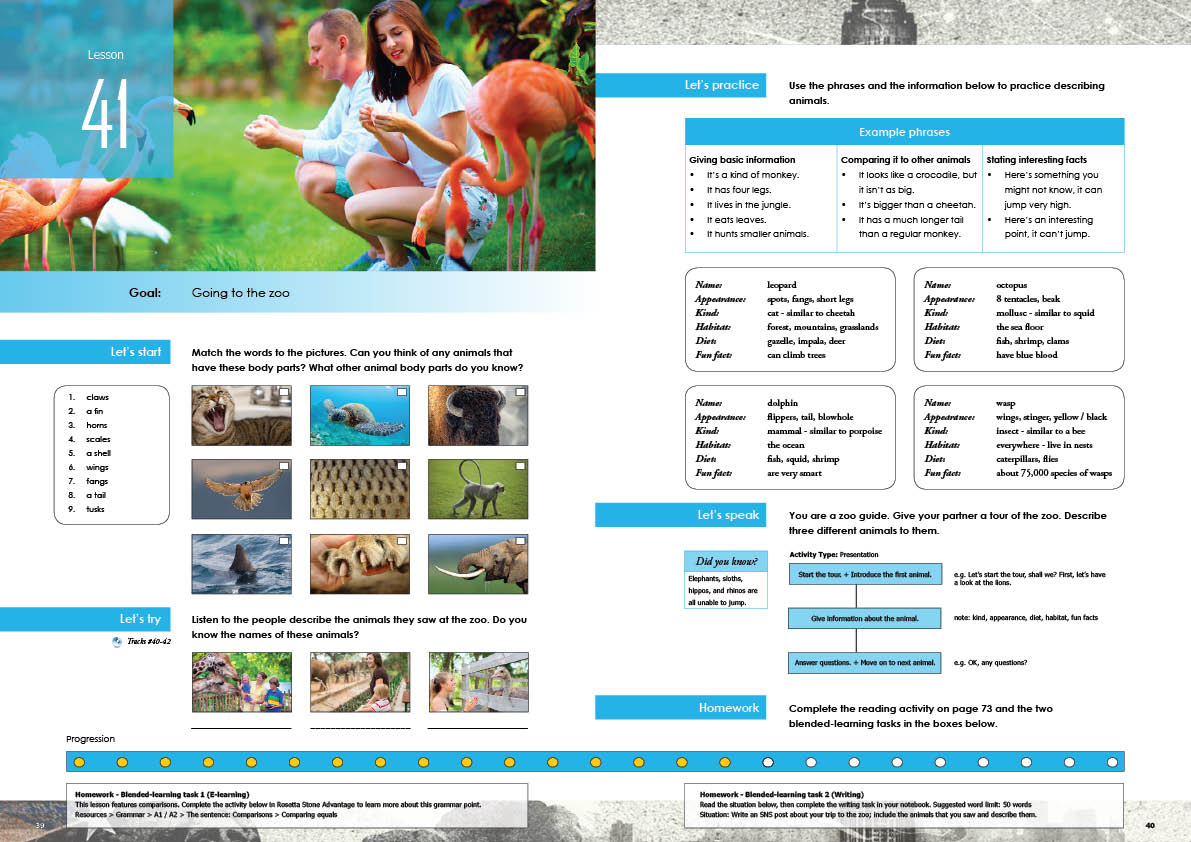
Manuals > General English > Rosetta Stone Advantage > Elementary - Book 3 > Lesson 41
< Previous Lesson | Next Lesson >

By the end of the lesson, the student should be able to describe an animal.
Communication strategies:
The student should be able to describe an animal by following the 4 steps below:
1) state the animal's name
2) describe what the animal looks like
3) describe where it lives and what it eats
4) share a fun fact about the animal
e.g.
This is a leopard. It has spots on its body. It has big fangs. It has short legs. It is a kind of cat. It is similar to a cheetah. It can live in forests, mountains or grasslands. It eats gazelles, impalas, and deer. Here's a fun fact, leopards are very good climbers. They can easily climb trees.
Words and rules:
- The student should be able to use the simple present tense to state facts e.g. Elephants live in Africa.
- The student should know vocabulary related to animal body parts e.g. a trunk
- The student should be able to use comparatives / equalitives / superlatives (bigger / as big as / biggest)
Appropriateness:
Non-verbal behaviour: NA
Register: NA
Social rules: NA
Cultural references: NA
Track #40
Yesterday at the zoo I saw a strange animal. I don’t remember what
it was called. It’s really tall. It has lots of spots. It has four legs, a tail,
and a long neck. It lives in Africa and eats the leaves off trees.
Track #41
These are really big animals. They live in Africa and Asia, but the
African ones are bigger than the Asian ones. They have two big
teeth called tusks, really big ears, and a really long nose called a
trunk. They mainly eat fruits and vegetables. Also, I heard they can’t
jump.
Track #42
I saw a really big bird at the zoo the other day, but I don’t remember
its name. It had black feathers, a long neck, and two long legs. It can
run very fast, over 70km/hr but it can’t fly. Here’s an interesting fact,
this bird has three stomachs.
Because the lesson touches on the topic of animals, you are welcome to introduce some of the following vocabulary if you like.
1) cold-blooded (adj)
2) social (adj)
3) fish (adj)
4) venomous (adj)
5) poisonous (adj)
6) carnivorous (adj)
7) herbivorous (adj)
8) furry (adj)
9) tame (adj)
10)
nocturnal (adj)
Option 1:
Difficulty ★★
Type:
Let's start - Warm-up discussion
Purpose:
Steering the student into the goal of the lesson before opening the book.
Method: Before you open the book, talk to the student about what animals they like and why.
Option 2:
Difficulty ★★
Type:
Let's start - Vocabulary introduction
Purpose:
Teaching the students about animal groups so that can use it later in the lesson
Method: Tell the student there are 6 basic categories of animals. Work together to name the 6 categories, then brainstorm some animals for each category.
1) amphibians (n) [newts, salamanders, toads, frogs]
2) birds (n) [feathers, bills, can fly]
3) fish (n) [scales, can swim]
4) invertebrates (n) [no backbone]
5) mammals (n) [have hair and are warm blooded]
6) reptiles (n) [scales and the ability to lay hard-shelled eggs]
Option 3:
Difficulty ★★★
Type:
Let's start - Vocabulary introduction
Purpose:
Teaching the students about animal specific vocabulary so that can use it later in the lesson
Method: Together with the student come up with some words to describe where an animal lives, how an animals moves
e.g. rabbit
Where it lives: a burrow
How it moves: hops
Let’s start
Top left: fangs
Top middle: a shell
Top right: horns
Middle left: wings
Middle middle: scales
Middle right: a tail
Bottom left: a fin
Bottom middle: claws
Bottom right: tusks
Let’s try
Giraffe
Elephant
Ostrich
Let’s practice
Name: leopard
Appearance: spots, fangs, short legs
Kind: cat - similar to cheetah
Habitat: forest, mountains, grasslands
Diet: gazelle, impala, deer
Fun fact: can climb trees
Expected outcome
This is a leopard. It has spots on its body. It has big fangs. It has short legs. It is a kind of cat. It is similar to a cheetah. It can live in forests, mountains or grasslands. It eats gazelles, impalas, and deer. Here's a fun fact, leopards are very good climbers. They can easily climb trees.
Let’s speak
Role-play showing someone around a zoo
Hello everyone. My name is Steve. I'm a zookeeper here at Tokyo zoo. Today I'm going to give everyone a tour of the zoo. Let's go! This here is the elephant area. Elephants are large mammals with a long trunk and tusks. There are two main kinds of elephants, African elephants and Asian elephants. The Asian elephants are smaller than the African ones. Elephants are herbivorous and can be found in different habitats including savannahs, forests, deserts and marshes. Here's a fun fact, did you know that elephants can't jump? OK, Let's go onto the next area...